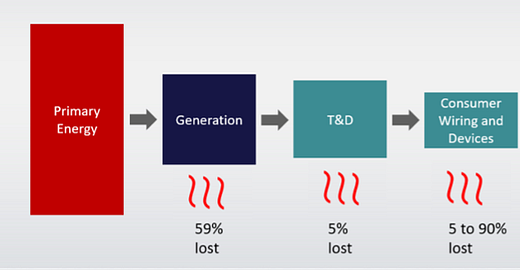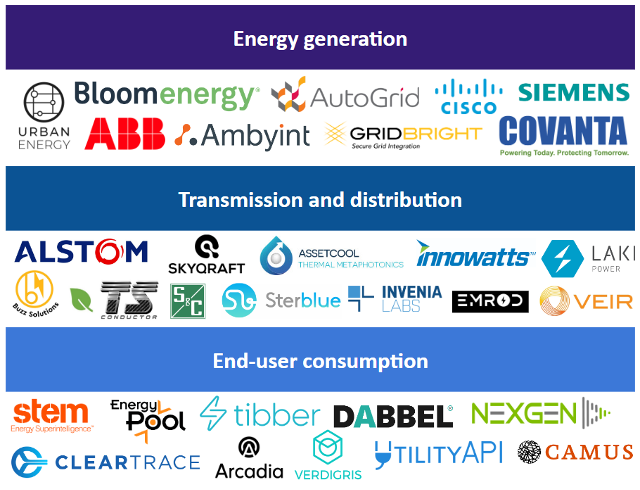Gigaton Potential
According to the International Energy Agency, 34 gigatons of CO2 emissions can be saved each year if net-zero policies for the electricity industry are installed by 2050. The biggest innovation opportunities include advancements in batteries, hydrogen electrolyzers, and consumer choices (e.g. modifying a house with energy-efficient technologies).
For reference: in 2019, the world emitted 51 gigatons of CO2-equivalent greenhouse gases. Project Drawdown estimates we need to cumulatively eliminate 1,000 GT from 2020-2050 to keep global warming below 2 degrees Celsius.
You Might Be Interested If…
You recognize the need to improve the fundamental yet inefficient electricity system
You are excited to invent novel, efficient technologies
You wish to reduce emissions in your own household in a cost-effective manner
You want to introduce and discover solutions that can scale around the world
What You Should Know
Inefficient electricity generation, transmission, and distribution account for 40% of global greenhouse gas emissions. The Intergovernmental Panel on Climate Change states that the energy supply sector is the largest energy user, accounting for 18 gigatons of CO2 emissions each year. According to American Council for an Energy-Efficient Economy (ACEEE), driving energy efficiency can achieve half the greenhouse gas emission reductions needed to meet US climate goals. However, only 32 countries out of almost 200 mention grid efficiency in their commitments to the 2015 Paris Climate Agreement.
Figure 1. Energy lost during generation, transmission and distribution, and consumer end-use. Used with permission from Enerdynamics.
Losses from the conversion of primary energy (conventional fuels and renewables) into electricity are around 2/3 of the input energy. These inefficiencies arise from inherent losses when heat is converted into mechanical energy to turn generators. According to the US Energy Information Administration, natural gas plants can lose around 55% of input energy, coal plants can lose 68%, and nuclear plants can lose 65%. Renewables suffer worse losses at ~70% for solar and wind energy.
Figure 2. Energy lost from electricity generation in 2021, with units in quadrillion BTU. Publicly available from the US Energy Information Administration.
Approximately 40% of distribution losses are due to under-developed distribution transformers and 25% of losses are due to leaks from conductors and cables. Furthermore, replacing a single light bulb with an Energy Star-rated LED bulb in every US home would decrease GHG emissions by 9 gigatons, equivalent to the emissions of 800,000 cars.
The total global investment in the energy supply sector in 2010 was USD 1,076 to 1,350 billion per year. Kainuma et al. estimate that $190 billion to $900 billion/year in additional investments are required by 2050 to limit the temperature increase below 2 °C.
Key Players
Energy generation
The energy generation industry includes the renewable energy sector and innovation in the generation systems in place.
Electricity generator companies such as Caterpillar, Generac, and Kohler Energy have set sustainability goals to reduce operations waste and emissions by 2030. Cummins has partnered with Iberdrola to produce large-scale hydrogen fuel cell technology for electrolysis projects.
Urban Energy, Bloomenergy, and Covanta incorporate sustainable energy sources into the grid with solar panels and energy-to-waste strategies.
AutoGrid and Gridbright offer electric industry consultants to negotiate generation interconnection, battery storage, and sustainable energy agreements.
Transmission and distribution
Most transmission and distribution companies focus on data collection for inefficiencies or novel technology to reduce electricity waste.
Cisco, Alstom, and S&C Electric Co. are developing synchrophasors to gather real-time data on line efficiency.
VEIR debuted a zero-resistance line using high-temperature superconductors and a novel cooling system.
Skyqraft, Laki Power, Innowatts, Buzz Solutions, Sterblue, and Invenia Labs conduct electricity line inspections using AI.
End-user consumption
From light bulbs to monitoring energy consumption, companies are focused on improving end-user efficiency.
Stem, EnergyPool, Dabbel, and Verdigris work with industrial constituents to pinpoint hidden inefficiencies and reduce demand charges.
Tibber, Nexgen, UtilityAPI, and CAMUS link resident consumers with local generators that cut down on cost and waste.
ClearTrace and Arcadia encourage renewable energy consumption by monitoring energy footprints and connecting them with sustainable energy sources.
Opportunities for Innovation
⚡ High-voltage transmission lines
China’s “smart grid” utilizes high-voltage direct current transmission lines with minimal electricity waste at a scale of 1.1 million volts.
Sweden’s ABB and Germany’s Siemens are enhancing their generation systems to become comparable to “smart grid” technology.
💡 Switching to LEDs
The US Department of Energy has released cost-saving energy efficiency standards for light bulbs, which will slash 222 million tons of carbon emissions over the next 30 years.
About the Author:
Michelle Park hails from Stanford University. She is passionate about the field of physics, specifically astrophysics and particle physics. Michelle enjoys photographing the night sky and spreading awareness about light pollution through her community initiative Project DeLight.
🥳 What did you think? Let us know here.
Sources
https://www.greentechmedia.com/articles/read/1-2-trillion-metric-tons-of-co2-in-line-losses
https://www.ipcc.ch/site/assets/uploads/2018/02/ipcc_wg3_ar5_chapter7.pdf
https://www.aceee.org/sites/default/files/halfway-there-0919.pdf
https://www.future-energy-partners.com/post/energy-losses-in-power-generation
https://www.eia.gov/totalenergy/data/flow-graphs/electricity.php
https://homeguides.sfgate.com/changing-light-bulbs-environment-70834.html
https://www.tandfonline.com/doi/abs/10.1080/14693062.2012.738016






